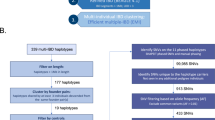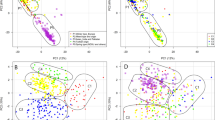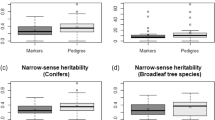Abstract
Family trees have long been a valuable visual tool for geneticists in identifying clusters of inherited traits and genotypes. As more data are collected, drawing the graphs by hand becomes impractical and, for this reason, we have developed the pedigree software CraneFoot. It can process any family graph with minimal computational cost by making a pedigree transformation that enables the use of a linear node positioning algorithm. The program is designed for automated drawing to printed media and efficient visual classification of genetically interesting families from large data sets. It also incorporates a robust pedigree topology check with detailed error messages.
Similar content being viewed by others
Log in or create a free account to read this content
Gain free access to this article, as well as selected content from this journal and more on nature.com
or
References
Wetherell C, Shannon A : Tidy drawings of trees. IEEE Trans Software Eng 1979; SE-5: 514–520.
Reingold EM, Tilford JS : Tidier drawings of trees. IEEE Trans Software Eng 1981; SE-7: 223–228.
Walker JQ II : A node-positioning algorithm for general trees. Software Pract Exp 1990; 20: 685–705.
Tores F, Barillot E : The art of pedigree drawing: algorithmic aspects. Bioinformatics 2001; 17: 174–179.
Plendl HJ : Stammbäume zeichnen mit PED 4.2. Medizinische Genetik 1998; 1: 50–51.
Brun-Samarcq L, Gallina S, Philippi A et al: CoPE: a collaborative pedigree drawing environment. Bioinformatics 1999; 15: 345–346.
Garbe JR, Da Y : Pedigraph 2.0, a software tool for the graphing and analysis of large complex pedigrees, 2004, Abstract book, p. 242, ADSA-ASAS-PSA Joint Annual Meeting, St Louis, July 25–29.
Bennet RL, Steinhaus KA, Uhrich SB et al: Recommendations for standardized human pedigree nomenclature. Am J Hum Genet 1995; 56: 745–752.
Buchheim C, Junger M, Leipert S : Improving Walker's algorithm to run in linear time. Lecture Notes Comput Sci 2002; 2528: 344–353.
Acknowledgements
This work was conducted with the support of the graduate school of Electrical and Communication Department at Helsinki University of Technology, Jenny and Antti Wihuri Foundation, Folkhälsan Research Center and Academy of Finland Grants for MW (No. 00213) and KK (No. 209286). The Finnish Diabetic Nephropathy Study (FinnDiane) was supported by grants from the Folkhälsan Research Foundation, Samfundet Folkhälsan, the Research Funds of the Helsinki University Central Hospital, the Wilhelm and Else Stockmann Foundation, the Sigrid Juselius Foundation, European Comission (Contract No. QLG2-CT-2001-01669), and the Liv och Hälsa Foundation.
Author information
Authors and Affiliations
Corresponding author
Rights and permissions
About this article
Cite this article
Mäkinen, VP., Parkkonen, M., Wessman, M. et al. High-throughput pedigree drawing. Eur J Hum Genet 13, 987–989 (2005). https://doi.org/10.1038/sj.ejhg.5201430
Received:
Revised:
Accepted:
Published:
Issue date:
DOI: https://doi.org/10.1038/sj.ejhg.5201430
Keywords
This article is cited by
-
Genotype phasing in pedigrees using whole-genome sequence data
European Journal of Human Genetics (2020)
-
Rediscovering the value of families for psychiatric genetics research
Molecular Psychiatry (2019)
-
Genetic ME–a visualization application for merging and editing pedigrees for genetic studies
BMC Research Notes (2015)
-
Helium: visualization of large scale plant pedigrees
BMC Bioinformatics (2014)
-
Mega2: validated data-reformatting for linkage and association analyses
Source Code for Biology and Medicine (2014)



